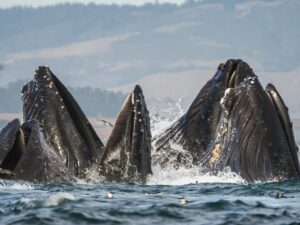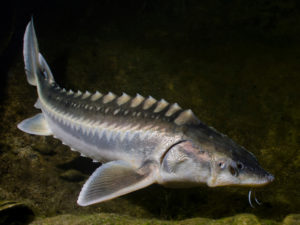One should not, of course, anthropomorphize, but this right here is a very large group of very fat and happy birds.
They are birds — scaups, mainly, with a few ruddy ducks and buffleheads tossed in — that have supped well this holiday season. They are birds that are now groaning contentedly, unclipping the snaps on their waistbands and calling for sorbet and coffee.
You’ll see them all around the North Bay the next few days, following the annual Richardson Bay spawning of Pacific herring. The run itself takes place offstage underwater, and features about 80,000 tons of small fish swimming toward shallow shorelines to spawn and lay eggs, but it has quite the above-water following. Ducks and gulls chow down on the roe, which washes ashore and now lies like a thick mustard-colored bathtub ring around the edge of Richardson Bay. Pelicans, cormorants, sea lions, harbor seals and porpoises gulp down the fish. And of course people follow the fish, and follow the animals following the fish: commercial fishermen track the herring and move in for the season’s catch, and birders fan out with spotting scopes on every promontory that promises a rare sighting.
The herring run and its entourage is in fact one of San Francisco Bay’s great and wonderful natural phenomena: an event, a scene, a happening, made all the more precious because a reasonably short time ago it looked like it might never return.

It has, happily, returned in style. On Richardson Bay Monday morning there were probably 5,000 feeding birds in a giant raft. There were birders lined up around the point in downtown Tiburon, where thousands of gulls argued noisily over the herring roe that blanketed the rocks. At Paradise Beach on Tiburon’s east edge, thousands more gulls drifted in the shallow water as just offshore a group of sea lions barked their compliments to the chef.
Audubon California’s Anna Weinstein, a seabird conservation biologist, and Garrison Frost, the organization’s communications director, met me in Tiburon to look at the assembled ducks, and we had only walked a quarter-mile before they ran into Jordan Wellwood, the director of the Richardson Bay Audubon Center and Sanctuary. The herring run draws a crowd.
“This is a special event for us because we don’t get a chance to be out in nature together that often,” Weinstein said of the chance to admire the birds with her colleagues, and then, turning her attention to what looked like a debris field of birds on the water, “Look at that raft. That’s amazing!”
And what’s cool, Wellwood added, is that while birders have a reputation for focusing mainly on unusual birds, the herring run creates a different kind of unusual: reasonably common birds in absolutely immense numbers. Like this:

“Unusual is not what we’re excited about,” Wellwood said. “Five thousand scaup is exciting.”
Wellwood, Frost and Weinstein watched through a spotting scope, resolving that lightning-bolt slash of black into a seething mass as the birds dove and splashed and collided, like a giant confused run of bumper cars. Three weeks ago Richardson Bay Audubon recorded its highest-ever count in its bimonthly bird survey, tallying 21,292 birds (including more than 16,000 scaups), and Weinstein said she thinks it’s probably because the herring are so abundant this year. The bird count at Richardson Bay has increased the last few years, she said, corresponding to increases in herring abundance.
And the herring are again abundant. From a historic low of 4,800 tons spawning biomass in San Francisco Bay in 2008-2009, the herring have rebounded to almost 80,000 tons in 2012-2013, and they’ve recovered to a point where they’re again supporting a fishery, human and otherwise. On a day like Monday, it’s easy to think about the sea lions (numbers increasing) and porpoises (numbers increasing) and birds (highest-count ever), all of them filling up on mass-spawning herring (numbers increasing) and think, yeah, this Bay’s doing OK.
That, Weinstein cautioned, would be a perilous complacency.
“I wouldn’t be complacent at all,” she said. “The reason the herring have come back is, first, responsible fishing, and second, great ocean conditions. Our work is not done.”

In fact, Weinstein said, this is a critical moment for securing the future of the herring run, and ensuring a healthy future for the fish and everything that depends on them. Herring provide an enormously high-energy winter food source for birds, increasing the birds’ reproductive success when they head north in the summer to breed. One recent paper ties the migration of surf scoters — charismatic sea ducks that Wellwood called Audubon Richardson Bay’s “poster bird” — to herring spawning grounds in Western North America.
But San Francisco Bay is one of only two areas on the entire West Coast where herring biomass is increasing. (The other is the Strait of Juan de Fuca between Washington and British Columbia.) Climate change and habitat loss are affecting herring everywhere, and overfishing is a problem outside the Bay. And that means both trouble for the animals that rely on herring up and down the coast, and increased pressure on the herring in San Francisco Bay.
The herring recovery in the Bay can be credited to good policy and responsible fishing, Weinstein said, but that policy is entirely ad-hoc, and now, she said, is the chance for the state to create a coordinated management plan for the entire Bay fishery and make permanent those good practices.
So Weinstein’s trip out to nature, to watch the birds and marvel at what 80,000 tons of spawning biomass does to a place, is tinged with political urgency. The annual event is a captivating circus, yes, and a reminder of nature’s glory, but it’s also an opportunity and a reminder, as Weinstein and Wellwood put it, that it is not yet time to hang a Mission Accomplished banner over the spawning fish.

Early in the day, while Weinstein and Wellwood are parked behind a spotting scope admiring the raft of ducks, a man walks by and pauses.
“What’s that duck right there?” he asks, pointing nonspecifically at the 5,000-bird assemblage.
A brief pause.
“A scaup,” Weinstein says. “S-C-A-U-P.”
The man digests the information and pronunciation.
“Any characteristics?” he asks.
There’s another pause.
“Well,” Weinstein says, deliberately, “they like to eat the herring roe that’s out there.”





